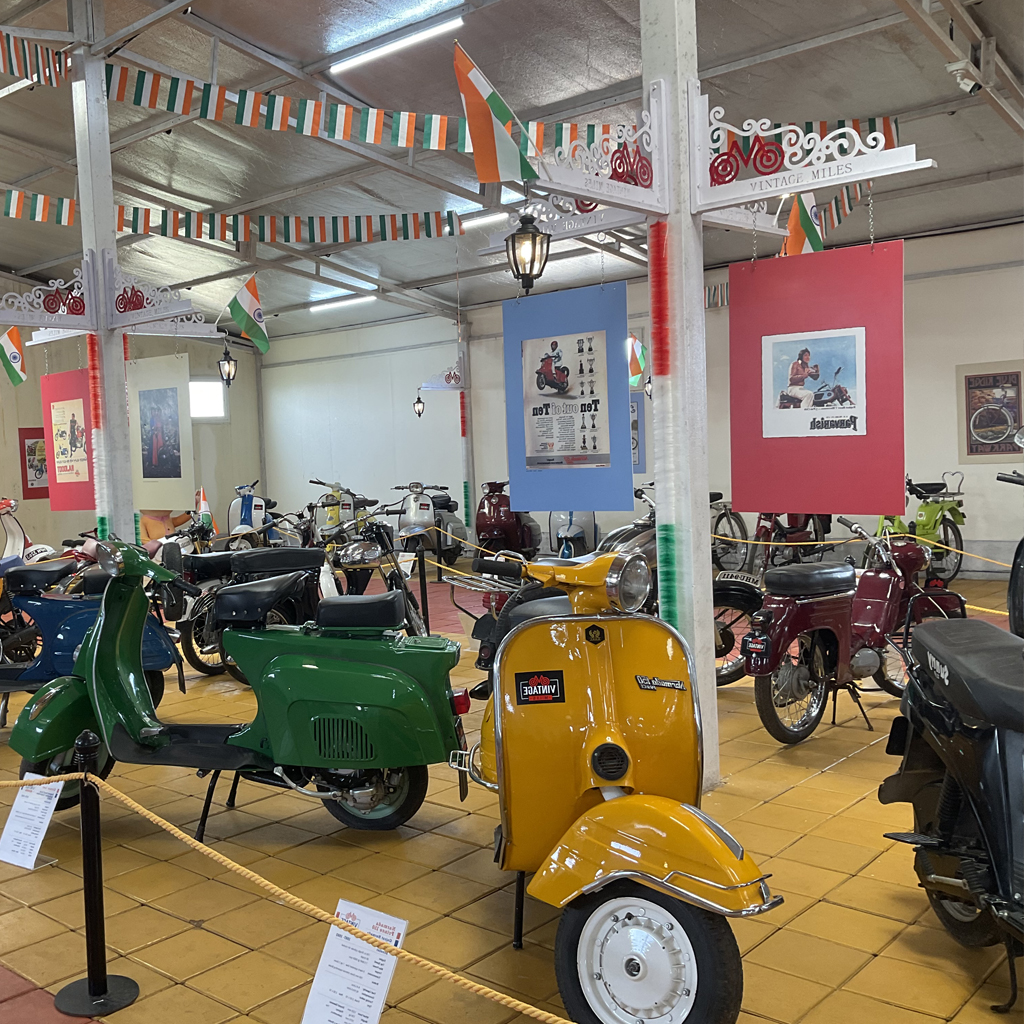
What sets Vintage Miles apart is our unwavering commitment to meticulous restoration. Each two-wheeler in our collection has been lovingly brought back to life, preserving their originality and historical significance. We’ve painstakingly researched and delved into the design, engineering, and production secrets behind these classics. Our dedicated team of passionate
tour guides goes above and beyond to breathe life into the lost stories and hidden tales of these machines, providing you with an immersive and enlightening experience.
From the revolutionary scooters of Bajaj Auto and the entry of global giants like Suzuki, Honda, and Yamaha, our collection tells the tale of the industry’s evolution. We’ve even embraced the future by including electric-powered two-wheelers, promoting sustainable transportation and showcasing the ongoing innovation in the industry.
It’s a matter of immense pride when we witness visitors reliving their memories and discovering the forgotten stories behind their favorite two-wheelers. The joy of reconnecting with your grandfather’s, father’s, or even your own first two-wheeler is unparalleled. It’s an honor to provide a space where these cherished memories can be revived and shared with loved ones.

So, join us at Vintage Miles and allow us to take you on an enthralling ride through the
captivating history of the Indian two-wheeler industry.
Immerse yourself in the nostalgia, discover hidden tales, and appreciate the passion and craftsmanship that have shaped this remarkable industry. Welcome to Vintage Miles, where the legacy of Indian 2-wheelers thrives!

1960 - 1970
The Roaring Beginnings
The 1960s marked the emergence of the Indian two-wheeler industry, as the nation embarked on a journey of industrial growth. During this period, the industry was tightly regulated by the government, with licenses required for manufacturing and collaborations with foreign companies encouraged. It was a time when scooters ruled the roads, with Automobile Products of India (API) leading the charge. However, Bajaj Auto soon took the reins and began manufacturing scooters in collaboration with Piaggio of Italy, adding a touch of Italian flair to Indian roads. The industry was vibrant, with players like Enfield India Ltd., Bajaj Auto Ltd., and Ideal Jawa Pvt. Ltd. bringing iconic motorcycles and scooters to the market.
1971 - 1980
A Rollercoaster Ride
The 1970s were a rollercoaster period for the Indian two-wheeler industry. On one hand, the industry experienced high growth rates, driven by the increasing demand for fuel-efficient vehicles, especially scooters. However, the ride wasn’t all smooth. The government introduced regulatory policies like the Monopolies and Restrictive Trade Practices Act (MRTP) and the Foreign Exchange Regulation Act (FERA) to control and monitor the industry. While these measures aimed to prevent monopolies and regulate foreign investments, they also impacted the industry’s dynamics. Large players like Bajaj Auto Ltd. faced limitations on their growth, and foreign collaborations in the motorcycle segment suffered, hindering technological advancements. Despite the challenges, new players like Kinetic Engineering Ltd. and LML entered the moped and scooter segments, injecting fresh energy into the industry.
1981 - 1990
Winds of Change
The 1980s brought winds of change to the Indian two-wheeler industry. The government recognized the need for technological advancements and reforms. In 1981, foreign collaborations were allowed for two-wheelers with an engine capacity of up to 100 cc, ushering in a new era of innovation. This policy shift led to a surge in new players and partnerships. The industry witnessed the entry of renowned names like TVS Suzuki, Bajaj Auto Ltd., Escorts Ltd., Hero Majestic Ltd., and Kinetic Engineering Ltd., who joined forces with international giants such as Suzuki, Kawasaki, Yamaha, and Honda. These collaborations paved the way for the introduction of exciting new models like Ind-Suzuki motorcycles, Kawasaki Bajaj motorcycles, Yamaha RX motorcycles, and Hero Honda motorcycles. The government also eased control measures, delicensing industries, and allowing “broadbanding” in 1985, as part of the New Economic Policy (NEP).
1991 - 2000
The Road to Liberalization
The 1990s brought about a seismic shift in the Indian economy, with liberalization and deregulation taking center stage. The two-wheeler industry experienced complete deregulation, opening doors to new opportunities and challenges. Trade reforms were implemented to enhance competitiveness in the global market. Bajaj Auto Ltd., TVS, and Kinetic Honda emerged as key players, navigating the changing landscape. However, the industry faced a temporary setback due to a recession caused by rising fuel prices, high input costs, reduced purchasing power, and credit crunch in consumer financing. Despite the obstacles, the industry gradually regained its momentum, and new players continued to contribute to its growth.
The Indian two-wheeler industry has come a long way since its humble beginnings. From being tightly regulated to embracing liberalization, it has witnessed the rise of iconic brands, technological advancements, and changing consumer preferences. Today, it stands as a testament to the resilience, innovation, and dynamism of the Indian automotive sector.